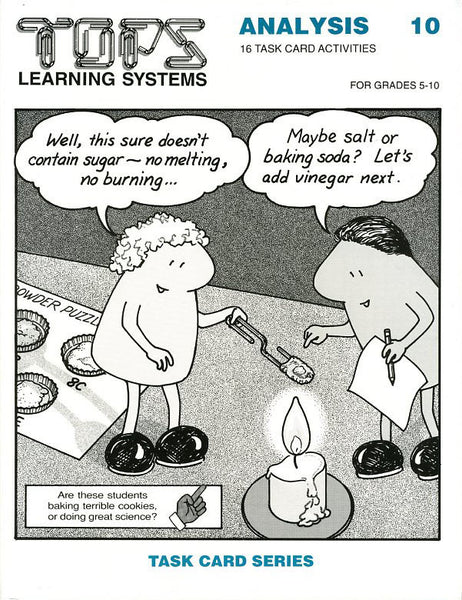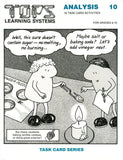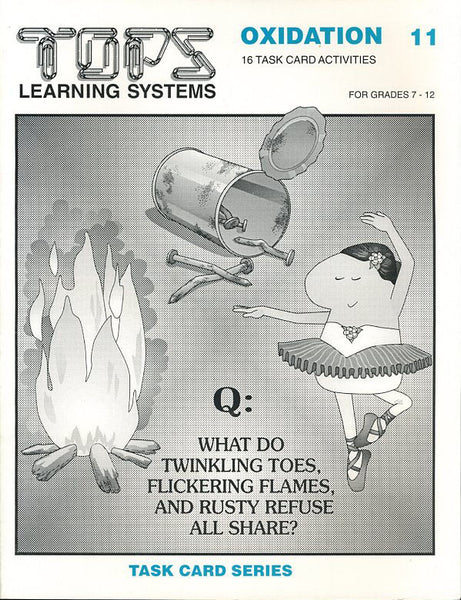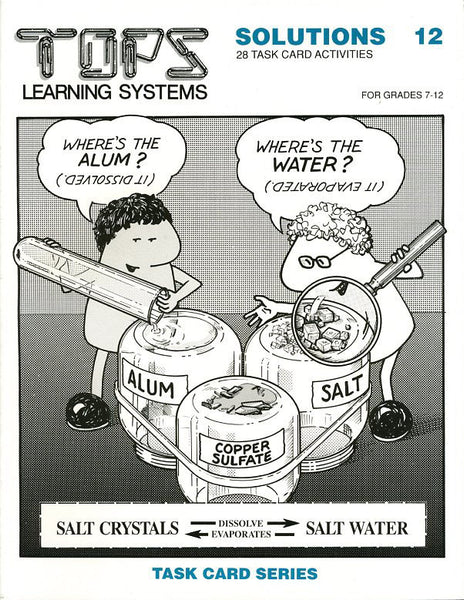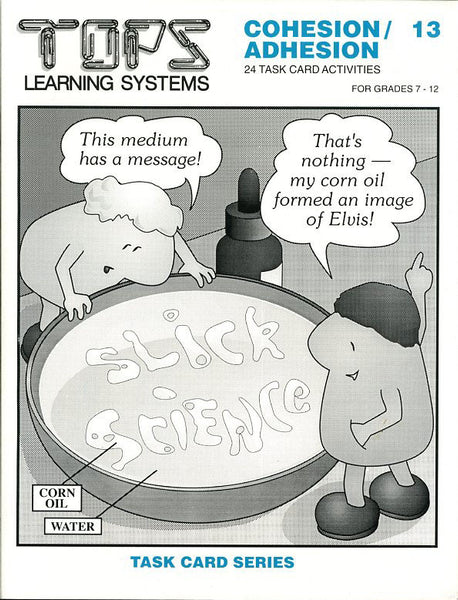#10 Analysis (grades 5-10)
Regular price $20.95
Soft-bound, 48 page book, 16 reproducible task cards, full teaching notes.
An excellent introduction to chemical analysis, even for students with no chemistry background. Follow simple flowcharts to separate mixtures, observe safe interactions between household substances, compare pH, and more. Simple and elegant.
Click here for a complete list of materials and convenient shopping.
* 1/10/10: small graduated cylinders, 10 mL1/1/1: jar of sand
1/1/1: source of water
1/10/10: Bunsen burners (or an electric hot plate or warm radiator)
* 2/20/20: Pyrex beakers, 50 to 100 mL capacity (or substitute crucibles or tuna cans)
2/20/20: watch glasses (or substitute tin can lids or crucibles or squares of cardboard)
1/10/10: tongs (or substitute clothespins)
1/10/10: scissors
* 1/10/10: gram balances
1/1/1: bottle sublimed sulfur
* 5/50/50: bottle caps
1/10/10: index cards
* 1/1/1: roll masking tape
1/1/1: packages each of: alum, baking soda, corn starch, salt and sugar. Include a dispensing spoon with each box.
1/10/10: dropper bottles each of: white vinegar, iodine, water and ammonia.
* 2/20/20: additional dropper bottles
* 1/10/10: paper clips
* 1/1/1: rolls aluminum foil
* 1/10/10: candles with drip catchers (or Bunsen burners or alcohol lamps)
* 5/10/5: baby food jars or equivalent with lids
* 10/100/100: strips each of red and blue litmus paper
1/1/1: roll waxed paper
* 1/1/1: small portions each of cleanser and garden lime dispensed in labeled lids
1/10/10: aspirin tablets
* 1/10/10: straight pins
1/1/1: head red (purple) cabbage
1/2/2: lemons (bottled concentrate or ascorbic acid crystals)
1/1/1: can beets
1/10/10: seltzer tablets
- Lesson 1: To learn how to interpret flow chart instructions.
- Lesson 2: To separate a mixture of salt and sand following flow chart directions.
- Lesson 3: To separate a mixture of salt and sand quantitatively, following flow chart directions.
- Lesson 4: To develop a flow chart for quantitatively separating sand and sulfur.
- Lesson 5: To develop a reaction table to use as a reference for identifying unknown powders.
- Lesson 6: To react powders in combination and observe possible masking effects. To further refine a table of reactions to be used in identifying unknown powders.
- Lesson 7: To qualitatively analyze the composition of various mixtures of white powders, using testing agents that react in characteristic ways.
- Lesson 8: To continue analyzing the composition of various mixtures of white powder, using testing agents that react in characteristic ways.
- Lesson 9: To discover how litmus paper responds to acids, bases and neutral solutions.
- Lesson 10: To distinguish between water dilutions and acid-base neutralizations. To observe that the strength of an acid or base is reduced most effectively by neutralizing it.
- Lesson 11: To compare the relative strengths of vinegar and ammonia by titrating with litmus paper.
- Lesson 12: To investigate the properties of cabbage water as an acid-base indicator.
- Lesson 13: To examine the broad range of colors that cabbage water exhibits in response to acids and bases of various strengths.
- Lesson 14: To estimate the pH of acids and bases by observing color changes in cabbage water. To confirm these results with litmus paper.
- Lesson 15: To study how beet juice interacts with acids and bases. To correlate its color change with pH.
- Lesson 16: To observe how buffered solutions neutralize both excess acid and base to maintain a stable pH.
We encourage improvisation - it's one of the main goals of our hands-on approach! You and your students might invent a simpler, sturdier or more accurate system; might ask a better question; might design a better extension. Hooray for ingenuity! When this occurs, we'd love to hear about it and share it with other educators.
National Science Education Standards (NRC 1996)
TEACHING Standards
These 16 Task Cards promote excellence in science teaching by these NSES criteria:
Teachers of science...
A: ...plan an inquiry-based science program. (p. 30)
B: ...guide and facilitate learning. (p. 32)
C: ...engage in ongoing assessment of their teaching and of student learning. (p. 37)
D: ...design and manage learning environments that provide students with the time, space, and resources needed for learning science. (p. 43)
CONTENT Standards
These 16 Task Cards contain fundamental content as defined by these NSES guidelines (p. 109).
• Represent a central event or phenomenon in the natural world.
• Represent a central scientific idea and organizing principle.
• Have rich explanatory power.
• Guide fruitful investigations.
• Apply to situations and contexts common to everyday experiences.
• Can be linked to meaningful learning experiences.
• Are developmentally appropriate for students at the grade level specified.
Unifying Concepts and Processes
NSES Framework: Systems, order, and organization • Evidence, models and explanation • Constancy, change, and measurement • Evolution and equilibrium • Form and function
Core Concepts/Processes: Common household substances have acid-base properties which may be investigated with comon household pH indicators.
Science as Inquiry (content standard A)
NSES Framework: Identify questions that can be answered through scientific investigations. • Design and conduct a scientific investigation. • Use appropriate tools and techniques to gather, analyze, and interpret data. • Develop descriptions, explanations, predictions, and models using evidence. • Think critically and logically to connect evidence and explanations. • Recognize and analyze alternative explanations and predictions. • Communicate scientific procedures and explanations. • Use mathematics in all aspects of scientific inquiry.
Core Inquiries: Develop reaction tables and flow charts to test what substances unknowns contain (qualitative analysis) and how much they contain (quantitative analysis)
Physical Science (content standard B)
NSES Framework:Heat • Properties and changes of properties in matter • Chemical reactions • Interactions of energy and matter
Core Content:Flowcharts • Qualitative analysis • Quantitative analysis • Acids • Bases • Neutral solutions • pH • Titration • Buffers

